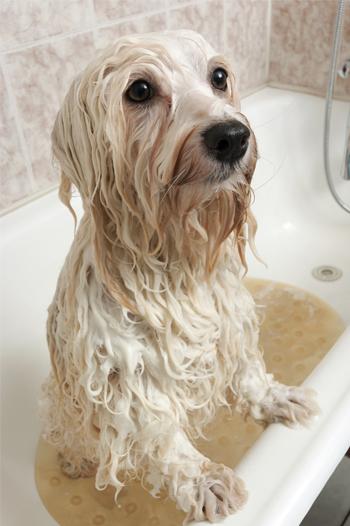Washing Harry the dog
Duration/age

Washing the dog can be a great activity on a hot day. There can be lots of discussion and negotiation as you try and wash your dog without ending up soaked.
Let’s call the dog 'Harry'.
Harry is a big dog and you will have to work hard to get him wet from head to tail.
Before starting, work out a plan about how you will wash Harry and who will do what.
Where will you start? What do you need to do first? Can you put the shampoo straight on or do you need to get Harry wet first? Who will get the water?
Talk with your child about size. If your dog is large, like Harry, you might need to wash him on the lawn with a hose. If you have a small dog they could be washed in a baby’s bath, a tub or in the bath.
Where should we wash Harry? Will Harry fit in the baby’s bath? Is he too big?
Will you use the hose to wet and rinse off the shampoo or will you carry buckets of water from the tap to pour over Harry?
What can we use to carry the water? Will we need little jugs or big buckets?
After you have washed Harry what do you need to do next? Do you need to get him dry? Does the temperature make a difference? Is your dog very hairy, like Harry, and always in need of a good rub down with a towel and a final dry with a hair dryer?
Materials you will need
- Bucket
- Hose
- Sponges
- Shampoo
- Tub
- The dog
Alternative tools
- Towel
- Bath tub
- Laundry sink
- Hair dryer
Skills this activity improves
Why does this matter?
Helping to wash the family dog is a great opportunity for children to be involved in planning, measuring and working out position and orientation. As you talk to your child about where you will wash the dog and where to start, your child will be listening to and following directions such as, 'pour the water over the head' or 'start at the back and work forward'.
Washing the dog involves measurement as you work out how much water to use and the size of the area you will need for washing the dog. Your child will begin to explore the relationship between the size of the animal and the capacity and size of the tools they need to complete the task. For example, if the dog is small then you do not need as large a bucket of water as for a large dog.
What does this lead to?
By washing the dog children are exploring the different ways we can measure, the range of tools we use for measuring and the different language we use to describe measurement.
Once your child has worked out the tools they need this will help them to explore how much space they will need for washing the dog. The size of the dog and the tools used will direct the amount of space that is needed. As they wash the dog they are learning that not only do they need space for themselves and the dog but also for the tools they will use. This may mean you need a bigger space.
Language to use
- Bucket, sponge, shampoo, water, hose
- Head, legs, back, tail, muzzle, chest, tummy, feet, hair, fur
- Long, short, big, little
- Front, back, top, bottom, underneath, over
- Woof, bark
Questions to use
- How much space do we need to wash our dog?
- Will we need a big bucket or a small bucket?
- Where can we wash our dog?
- Can we wash our dog if it is a cold day?
- How will we dry our dog?
Useful tips
- If your dog needs to be dried with a hair dryer, remember to talk to your child about the safety of water and electrical appliances.
- For safety information about pets and children see Pets, Parenting SA
- For other safety information see Living with toddlers or visit www.parenting.sa.gov.au.
- Remember to talk to your child in your home language.
More ideas
- Set up a doll washing activity.
- Set up a bowl of sponges with soapy water. Squeeze as hard as you can to make bubbles.
Variation by age
Birth to two year olds
- Create a water play area with lots of small buckets and containers in different sizes.
- Let your child help you to water the garden and fill the watering can.
- Wash the car together.
Three to five year olds
- Wash the car together.
- Let your child help you to water the garden and fill the watering can.
- Create a water play area with lots of buckets and containers in different sizes.
Questions to ask
- Which container is biggest?
- Which container is smallest?
- Is it full?
- Which one is empty?
Questions to ask
- How big is that container?
- How much do you think it will hold?
- How many cups can that bucket hold?
- Which is bigger?
- Can you reach the top?
Language to use
- Full, empty
- Top, bottom, middle
- Big, little, small, large
Language to use
- Full, empty
- Top, bottom, middle
- Big, little, small, large


